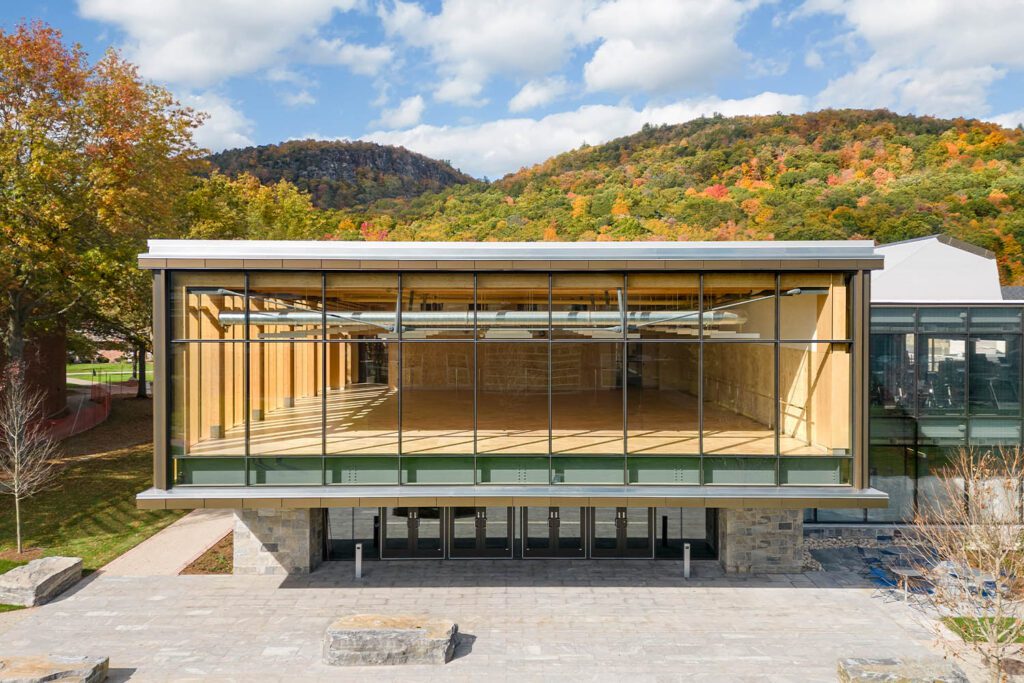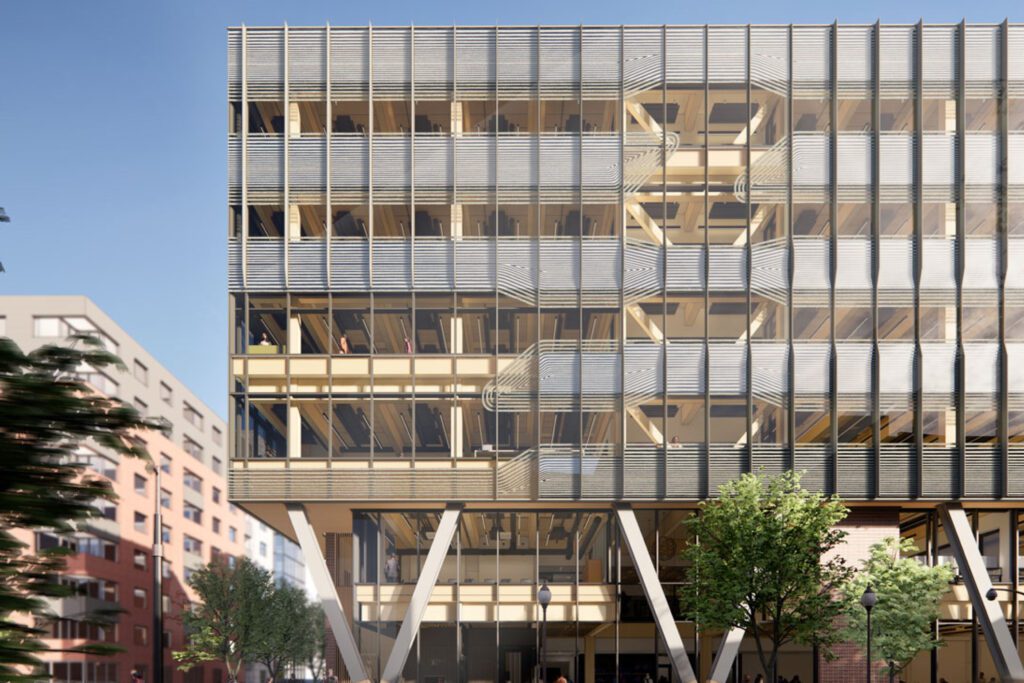Embodied carbon choices in action at Arizona State University
Embodied carbon is an issue in which all of us in the built environment can no longer ignore. The Rob and Melani Walton Center for Planetary Health at Arizona State University tells a story of deliberate engineering choices that have reduced embodied carbon at a high-performance research facility.
This is a climate change story.
As the climate crisis deepens and time begins to run out for meaningful action, it is necessary for the built environment to step forward. The need for action is clear when we look at the devastating impact of the climate emergency: rising temperatures, extreme weather events, and food and water insecurity.
Almost 40% of global greenhouse gas emissions are attributable to buildings and construction. Because of this, the built environment and the architecture, engineering and construction (AEC) industry must play a critical role in making significant changes to reduce and lessen the impact that carbon dioxide, methane and other gases have.
The Rob and Melani Walton Center for Planetary Health at Arizona State University (ASU) is a story of how engineering choices that consider – and actively attempt to reduce – embodied carbon will play a role in this revolution. In this piece we explore how decarbonization efforts led to a reduction in the embodied carbon within the concrete at ASU, and why this was important to both Buro Happold and our client.
Why is embodied carbon important to the built environment?
First, it is important to understand just how necessary the work is to reduce all forms of carbon with the built environment. The climate emergency will continue to disrupt more lives as it worsens. In particular, it will affect at-risk communities the most, such as ones that have already seen increased flooding and extreme heat.
The international treaty addressing climate change known as ‘The Paris Agreement’ looms large in these discussions. Its goal is to limit global warming to 1.5°C compared to pre-industrial levels. To achieve this, large scale and transformative change is needed. Buro Happold and many other firms have joined SE 2050 (the initiative that targets zero embodied carbon in structures by 2050) to align with this ambition and drive industry change.
The whole climate change story is that we can’t do business as usual anymore. Indeed, that’s the one thing we can’t do. We have to change.
Luke Lombardi, senior sustainability consultant
The built environment has historically contributed to problematic emissions, so we must now be part of the solution. The word ‘carbon’ is used as shorthand, but it is important to note that ‘carbon dioxide equivalent’ (CO₂e) is what is measured. This covers all the various gases that are emitted (including carbon dioxide and methane) that impact the environment.
Operational carbon is that which comes from the heating, lighting and use of buildings. In recent years, initiatives to reduce this have been extremely effective. It is now time to turn our attention to the global warming potential of ‘carbon’ within the manufacture, transportation, construction, maintenance and disposal of materials that make up a building or asset: embodied carbon.

Fraser Reid is associate principal in Buro Happold’s New York office, heading up a team of structural engineers. He led Buro Happold’s involvement in the development of the Rob and Melani Walton Center for Planetary Health at ASU and was central in the embodied carbon reduction work on that project. He said, “Now has to be the time for action. The next decade is absolutely crucial.
“We are in a climate emergency and structural engineers are rightly at the forefront of embodied carbon discussions. It is critical that structural engineers are aware of embodied carbon issues and know where they can make reductions on their projects. And we have to address this in terms of wider industry awareness, too. Being able to explain these issues to not just our immediate clients, but our end clients too, is very important.”
Luke Lombardi is a senior sustainability consultant based in Los Angeles. He said, “This is a climate change story. As engineers we have to help tell that story to our clients. As the grid decarbonizes and we get better and more efficient buildings on the operational side, materials and respect for our resources become more and more important on the embodied carbon side. We are seeing more and more people want to share good embodied carbon stories. This is becoming more of a mainstream story for a reason.”

Engineering decisions for positive embodied carbon outcomes
Depending on the type of building, there are certain actions that structural engineers will usually take when considering potential embodied carbon reduction. Fraser Reid explains, “Structural engineers have two main levers to reduce embodied carbon. First, we can design in a way where we use less new materials, because the most sustainable building from an embodied carbon perspective is the one that is already there. This is why we hear a lot from structural engineers about adaptive re-use and reducing the need for new construction.
“Second is procurement practises; we can work with suppliers to reduce the emissions associated with making those materials.”
Attention paid to embodied carbon is a differentiator for Buro Happold; we are a value driven company and sustainability is at the forefront of our values and the work we do.
Fraser Reid, associate principal
At the root of this is doing lifecycle assessment work, quantifying materials and quantifying global warming potential. It is normal to compare and optimise for things like cost or constructability; we now must do the same for carbon.
Fraser Reid added, “Attention paid to embodied carbon is a differentiator for Buro Happold; we are a value driven company and sustainability is at the forefront of our values and the work we do. We put in huge amounts of effort into how we account for the embodied carbon in our projects.
“The research center at ASU is a great example of how to reduce embodied carbon for a concrete structure. Early engagement with the contractor was key; they were involved from early in the design, so helped to drive system and material selection. Along with the architect, everyone bought into the importance of it early on.”
Luke Lombardi agrees that communication on the importance of considering embodied carbon is central to effecting positive change. He said, “There are themes that we see when we’re working on these embodied carbon projects, including the importance of breaking down silos and facilitating communication between experts. That is a really important part of this embodied carbon journey we are on.”
The Rob and Melani Walton Center for Planetary Health at Arizona State University
The new interdisciplinary science and technology research center, the Rob and Melani Walton Center for Planetary Health, was opened at Arizona State University in April 2022. This research facility houses spaces for biological sciences, engineering, life sciences and sustainability, with a particular focus on the sustainability of food, water and energy. It also has public outreach and exhibition spaces, a conference center and a 389-seat auditorium.
Because the principles of sustainability are central to the work the building will create, it is unsurprising that the design and development of the building considered embodied carbon and environmental impact. Structures are a ‘big ticket’ item in terms of reducing embodied carbon, and it here where Buro Happold’s work had a measurable effect.

The team implemented several strategies for reducing embodied carbon within the concrete. Floor systems were targeted as an area where innovative materials could reduce embodied carbon. A ‘voided slab’ system was used, removing concrete from within the floors that was not contributing structurally.
This reduces the weight, allows for longer span dimensions, and reduced loads on columns and foundations. In essence, it reduced the amount of concrete necessary, and thus, reduced levels of embodied carbon. This voided slab application (also known as ‘BubbleDeck’) reduced concrete volume in the slabs by approximately 25% and was used for about 50% of the elevated floors.
Fraser Reid explains the process. He said, “We recommend the use of the voided slab system because of the longer span dimensions, to reduce the amount of concrete and reduce embodied carbon. The voided slab system had never before been used in Arizona.
“We worked closely with the contractor to do comparative studies for each wing of the building and presented a solid concrete option versus the option of voided slabs. They conducted a cost comparison and determined that the voided slab system could reduce costs and embodied carbon, so it was a win-win for the client.
“This is a good example of us being aware that we know of the importance of these issues, but we also know clients have a budget to consider. If we can find those sweet spots of reduced cost and reduced carbon, that is where we are likely to have the most success.”

Concrete procurement was also critical. The structure is reinforced concrete construction with a 40% fly ash cement replacement. Fraser Reid said, “Not all concrete is equal. There is a lot you can do to reduce carbon in concrete through specification and working with contractors and suppliers. The best thing to focus on with concrete buildings for reducing embodied carbon is reducing cement content in a way that does not affect final strength. The most common way of doing that is through cement replacement materials; the contractor chose to do that through fly ash.”
Evidenced through embodied carbon comparative studies, Buro Happold estimates that 1,700,000kg total CO2e was eliminated through the use of voided slabs and cement replacement materials. The building is certified LEED Platinum.
The research center at ASU is a great example of how to reduce embodied carbon for a concrete structure.
Fraser Reid, associate principal
What next?
The Paris Agreement (as well as latest IPCC Assessment Reports) makes clear that we do not have time to waste in addressing the harm being done to the world. Action must be taken now if we are to meet the target of limiting warming to below 1.5°C to avoid catastrophic impacts of climate change. ‘Business as usual’ is no longer good enough.
Luke Lombardi said, “The whole climate change story is that we can’t do business as usual anymore. Indeed, that’s the one thing we can’t do. We have to change. Buro Happold offers the expertise to support our clients in how to make the necessary changes to meet their goals. Our cross disciplinary expertise help facilitate all the necessary conversations with stakeholders like clients, architects and contractors.”
The new ‘business as usual’ for Buro Happold and embodied carbon is the introduction of embodied carbon assessments as standard for structural engineering. The Rob and Melani Walton Center for Planetary Health at Arizona State University is an example of supporting clients in reducing their climate impact, as well finding a balance that will also reduce cost.


